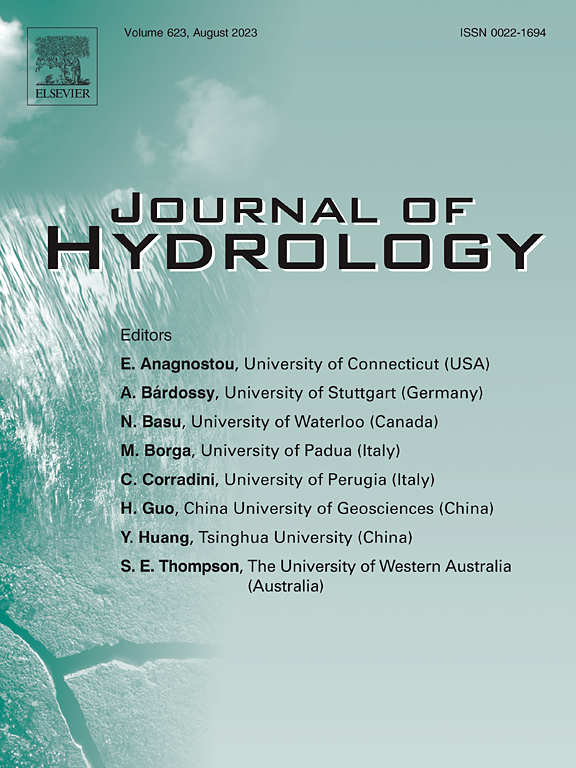探索对降水-径流依赖性的控制:对非平稳和空间异质性分析的影响
IF 5.9
1区 地球科学
Q1 ENGINEERING, CIVIL
引用次数: 0
摘要
气候变化和复杂的人为活动对理解降水-径流依赖性(PRD)提出了重大挑战。传统方法通常假设静态和线性条件,可能无法完全捕捉到这些复杂的关系。为解决这一局限性,我们提出了一个综合框架,其中包含非稳态和空间异质性分析,以确定影响降水-径流关系的控制机制。该框架适用于伊利诺斯河流域的 11 个子流域,该地区的特点是时空变化大,人为活动频繁。研究引入了新颖的降水-径流依赖性变化控制指数(CC-PRD),并采用地理探测器模型来有效识别和分析这些控制因素。我们的研究结果表明,在非稳态条件下,基流(BF)是所有子流域降水-径流变化的主要驱动因素。然而,其影响因流域类型而异:在城市子流域,基底流削弱了珠江三角洲,而在农村子流域,基底流则增强了珠江三角洲。除了 BF 外,城市子流域的人为因素,如不透水表面百分比(ISP)和农村面积百分比(RAP),成为影响珠江三角洲变化的主要驱动因素,而在农村子流域,自然因素,尤其是潜在蒸散量(PET),在影响珠江三角洲的变化中起着主导作用。从空间上看,PET、BF 和 RAP 是决定珠江三角洲变化的主要因素,它们与其他因素的相互作用显著扩大了其影响,占珠江三角洲变化的 90% 以上。这种综合方法加深了我们对珠江三角洲非稳态性和空间异质性的理解,同时考虑了气候变化和人类活动对稳态假设带来的挑战,从而为流域可持续发展战略提供了支持。本文章由计算机程序翻译,如有差异,请以英文原文为准。

Exploring controls on precipitation-runoff dependencies: Implications for non-stationary and spatially heterogeneous analyses
Climate change and complex anthropogenic activities present significant challenges to understanding Precipitation-Runoff Dependencies (PRD). Traditional methods, which often assume stationary and linear conditions, may not fully capture these complex relationships. To address this limitation, we propose an integrated framework that incorporates non-stationary and spatially heterogeneous analyses to identify the controlling mechanisms influencing PRD. This framework was applied to eleven sub-basins within the Illinois River Basin, a region characterized by high spatiotemporal variability and intense anthropogenic activity. The study introduces the novel Controlling Index for Changes in Precipitation-Runoff Dependencies (CC-PRD) and employs a geographical detector model to effectively identify and analyze these controlling factors. Our findings reveal that under non-stationary conditions, baseflow (BF) is the primary driver of PRD across all sub-basins. However, its impact varies by basin type: in urban sub-basins, BF weakens PRD, while in rural sub-basins, BF enhances PRD. Beyond BF, anthropogenic factors, such as impervious surface percentage (ISP) and rural area percentage (RAP), emerge as the key drivers of PRD variation in urban sub-basins, whereas in rural sub-basins, natural factors, particularly potential evapotranspiration (PET), play a dominant role in shaping PRD. Spatially, PET, BF, and RAP emerge as the main determinants of PRD, with their interactions with other factors significantly amplifying their influence, accounting for over 90% of its variability. This comprehensive approach enhances our understanding of the non-stationarity and spatial heterogeneity in PRD, while considering the challenges posed by climate change and human activities to the stationary assumption, thereby supporting strategies for sustainable watershed development.
求助全文
通过发布文献求助,成功后即可免费获取论文全文。
去求助
来源期刊

Journal of Hydrology
地学-地球科学综合
CiteScore
11.00
自引率
12.50%
发文量
1309
审稿时长
7.5 months
期刊介绍:
The Journal of Hydrology publishes original research papers and comprehensive reviews in all the subfields of the hydrological sciences including water based management and policy issues that impact on economics and society. These comprise, but are not limited to the physical, chemical, biogeochemical, stochastic and systems aspects of surface and groundwater hydrology, hydrometeorology and hydrogeology. Relevant topics incorporating the insights and methodologies of disciplines such as climatology, water resource systems, hydraulics, agrohydrology, geomorphology, soil science, instrumentation and remote sensing, civil and environmental engineering are included. Social science perspectives on hydrological problems such as resource and ecological economics, environmental sociology, psychology and behavioural science, management and policy analysis are also invited. Multi-and interdisciplinary analyses of hydrological problems are within scope. The science published in the Journal of Hydrology is relevant to catchment scales rather than exclusively to a local scale or site.
 求助内容:
求助内容: 应助结果提醒方式:
应助结果提醒方式:


